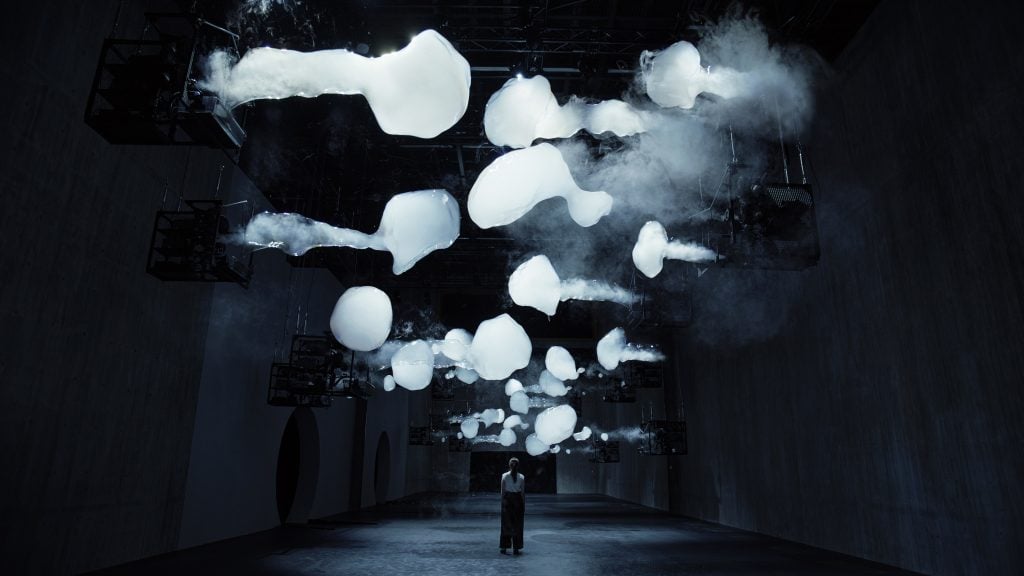In the bustling heart of Manhattan, where neon lights blink incessantly, billboards flash consumerist imagery, and the sounds of the city never cease, art duo A.A. Murakami have brought an ethereal respite. Their project “Floating World”, installed on the iconic digital screens of Times Square for the month, is an immersive, multi-sensory experience that conjures a “constellation of clouds” descending nightly over the city. This installation serves as a meditative and immersive pause in an environment typically defined by its relentless pace and overstimulation. The project is more than just a visual spectacle—it is an invitation to reconsider our relationship with the natural world, the digital environment, and the spaces in between.
A.A. Murakami’s Artistic Vision
A.A. Murakami, comprising Azusa Murakami and Alexander Groves, are known for creating immersive installations that often explore the intersection of nature, technology, and human experience. Their work frequently focuses on sensory engagement, blending the visual, tactile, and auditory to craft experiences that transport the viewer into otherworldly realms. The duo’s work is deeply rooted in the Japanese philosophy of Mono no Aware—a sensitivity to the transience of things—and this philosophy underpins much of their work. In “Floating World”, this idea is expressed through the ephemeral clouds that float and shift across the digital landscape of Times Square.
Murakami and Groves’ previous works have explored themes of impermanence, memory, and the tension between nature and industrialization. One of their most notable works, “The Alchemist’s Chamber”, invited viewers into a space where the boundaries between reality and illusion were blurred through the use of vapor, light, and sound. “Floating World” follows in this tradition, presenting a transient, dreamlike landscape that juxtaposes the organic softness of clouds with the harsh, unyielding digital screens that dominate Times Square.
This new work pushes their exploration of digital nature even further. While previous installations have utilized physical elements—such as vapor in their “New Spring” installation, which filled a room with bubbles that visitors could interact with—“Floating World” exists purely in the realm of the virtual. Yet, it still conjures a powerful sense of materiality, immersing viewers in a visual and emotional experience that transcends its medium.
Impression
Times Square is a public space unlike any other in the world. It is a site that embodies the contradictions of contemporary urban life: overwhelming consumerism exists alongside the democratization of public art; moments of connection occur in the midst of isolation. In many ways, “Floating World” stands as a counterpoint to the perpetual motion of Times Square. While the area is known for its constant barrage of advertisements and commercial imagery, A.A. Murakami’s installation offers a moment of calm and contemplation, asking viewers to look up, pause, and reflect.
The installation is significant not only because of its aesthetic qualities but also because of its social and spatial implications. Public art in Times Square is always a negotiation between the personal and the collective. With millions of people passing through the space daily, it is one of the most visible stages for contemporary art in the world. Yet, despite this vast audience, the experience of viewing public art in Times Square is inherently intimate. “Floating World”, with its soft, transient imagery, encourages this intimacy, asking viewers to stop for a moment and contemplate the fleeting nature of beauty and life itself.
Moreover, the installation’s digital nature speaks to the changing role of public art in an era increasingly dominated by screens and virtual experiences. The clouds in “Floating World” are not physical objects, yet they conjure a powerful sense of place and presence. In this way, the work engages with broader debates about the role of digital technologies in contemporary life. By transforming the screens of Times Square into a canvas for natural imagery, A.A. Murakami suggest that the digital world is not necessarily at odds with nature but can be a space for imagining new forms of connection and engagement with the natural world.
One of the most intriguing aspects of “Floating World” is its use of technology to create a meditative, immersive experience. In a city that never sleeps, technology is often seen as a force that accelerates life’s pace. Yet, A.A. Murakami have turned this assumption on its head. Rather than using technology to create spectacle, they use it to create stillness.
The choice to project clouds—a symbol of transience and impermanence—onto the rigid, glowing screens of Times Square is itself a powerful statement. It is a reminder that, despite our increasingly digital lives, we are still bound by the rhythms of nature. The clouds move slowly and gracefully across the screens, inviting viewers to slow down and reflect on their own place in the world.
This use of digital technology to create a sense of calm is part of a broader trend in contemporary art, where artists are increasingly using technology to create experiences that engage the senses and the emotions. A.A. Murakami’s work is part of a lineage that includes artists like Olafur Eliasson, whose immersive installations use light, color, and sound to evoke natural phenomena. However, what sets “Floating World” apart is its location: while many immersive installations are confined to gallery spaces, *Floating World* takes place in one of the most public, and most commercial, spaces in the world.
In this sense, the installation challenges the idea that technology is inherently alienating. Instead, A.A. Murakami suggest that technology can be a tool for connection, both to ourselves and to the world around us. By using the screens of Times Square—typically associated with commercialism and consumption—as a platform for art, the duo reclaims technology as a space for contemplation and reflection.
At its core, “Floating World” is a meditation on impermanence and transience, themes that have long been central to A.A. Murakami’s work. The installation’s title itself evokes the Japanese concept of Ukiyo, or “the floating world,” a term that originated in the Edo period to describe the fleeting, ephemeral nature of life and the pursuit of pleasure. In this context, the floating clouds of the installation can be seen as metaphors for the transient nature of existence. They move across the screens, momentarily appearing and then fading away, much like the moments of our own lives.
This idea of transience is particularly resonant in a place like Times Square, where the pace of life is relentless and everything seems to be in constant motion. In contrast, “Floating World” invites viewers to pause and consider the beauty of the fleeting moment. It is a reminder that, even in a world dominated by technology and commerce, there is still space for quiet reflection and contemplation.
Moreover, the installation engages with broader philosophical questions about the nature of reality and illusion. The clouds in “Floating World” are not real; they are digital creations projected onto screens. Yet, they have the power to evoke real emotions and create a sense of presence. In this way, the installation challenges our understanding of what is “real” and what is “illusion.” It suggests that, in the digital age, the boundaries between the two are increasingly blurred.
This blurring of boundaries is a recurring theme in A.A. Murakami’s work. In previous installations, they have used vapor, light, and sound to create spaces that feel simultaneously real and unreal. In “Floating World”, they take this exploration to a new level, using digital technology to create an experience that feels both otherworldly and deeply rooted in the present moment.
In many ways, “Floating World” is a reflection of our current moment. We live in an age where the boundaries between the physical and digital worlds are increasingly blurred, and where technology is both a source of connection and alienation. A.A. Murakami’s installation speaks to these tensions, offering a vision of how technology can be used to create spaces of contemplation and connection in a world that often feels overwhelming and disconnected.
Moreover, the installation is a powerful reminder of the importance of public art in the digital age. In a city like New York, where space is at a premium and commercialism dominates the landscape, public art offers a moment of respite, a chance to step out of the everyday and into a space of imagination and reflection. By transforming the screens of Times Square into a canvas for art, A.A. Murakami have created a space where the natural and digital worlds can coexist, offering viewers a moment of stillness in the midst of the chaos.
Ultimately, “Floating World” is not just a visual spectacle; it is a philosophical meditation on the nature of reality, technology, and the human experience. In an age defined by rapid technological advancement and constant change, the installation invites us to pause, reflect, and reconnect with the transient beauty of the world around us.
No comments yet.







